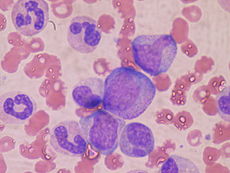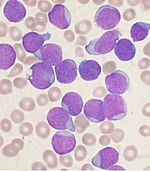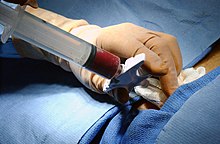Bone marrow
| Bone marrow | |
|---|---|
 A simplified illustration of cells in bone marrow | |
| Details | |
| Identifiers | |
| Latin | Medulla ossium |
| MeSH | D001853 |
| TA98 | A13.1.01.001 |
| TA2 | 388 |
| FMA | 9608 |
| Anatomical terminology | |
Bone marrow (Latin: medulla ossium) is the flexible tissue found in the interior of bones. In humans, bone marrow in large bones produces new blood cells. On average, bone marrow constitutes 4% of the total body mass of humans; in an adult weighing 65 kilograms (143 lb), bone marrow accounts for approximately 2.6 kilograms (5.7 lb). The hematopoietic compartment of bone marrow produces approximately 500 billion blood cells per day, which use the bone marrow vasculature as a conduit to the body's systemic circulation.[1] Bone marrow is also a key component of the lymphatic system, producing the lymphocytes that support the body's immune system.[2]
Marrow types

There are two types of bone marrow: medulla ossium rubra (red marrow), which consists mainly of hematopoietic tissue, and medulla ossium flava (yellow marrow), which is mainly made up of fat cells. Red blood cells, platelets and most white blood cells arise in red marrow. Both types of bone marrow contain numerous blood vessels and capillaries. At birth, all bone marrow is red. With age, more and more of it is converted to the yellow type; only around half of adult bone marrow is red. Red marrow is found mainly in the flat bones, such as the pelvis, sternum, cranium, ribs, vertebrae and scapulae, and in the cancellous ("spongy") material at the epiphyseal ends of long bones such as the femur and humerus. Yellow marrow is found in the medullary cavity, the hollow interior of the middle portion of long bones. In cases of severe blood loss, the body can convert yellow marrow back to red marrow to increase blood cell production.
Stroma
The stroma of the bone marrow is all tissue not directly involved in the primary function of hematopoiesis. Yellow bone marrow makes up the majority of bone marrow stroma, in addition to smaller concentrations of stromal cells located in the red bone marrow. Though not as active as parenchymal red marrow, stroma is indirectly involved in hematopoiesis, since it provides the hematopoietic microenvironment that facilitates hematopoiesis by the parenchymal cells. For instance, they generate colony stimulating factors, which have a significant effect on hematopoiesis. Cells that constitute the bone marrow stroma are:
- fibroblasts (reticular connective tissue)
- macrophages
- adipocytes
- osteoblasts
- osteoclasts
- endothelial cells, which form the sinusoids. These derive from endothelial stem cells, which are also present in the bone marrow.[3]
Macrophages contribute especially to red blood cell production, as they deliver iron for hemoglobin production.
Bone marrow barrier
The blood vessels of the bone marrow constitute a barrier, inhibiting immature blood cells from leaving the marrow. Only mature blood cells contain the membrane proteins required to attach to and pass the blood vessel endothelium. Hematopoietic stem cells may also cross the bone marrow barrier, and may thus be harvested from blood.
Mesenchymal stem cells
The bone marrow stroma contain mesenchymal stem cells (MSCs),[3] also called marrow stromal cells. These are multipotent stem cells that can differentiate into a variety of cell types. MSCs have been shown to differentiate, in vitro or in vivo, into osteoblasts, chondrocytes, myocytes, adipocytes and beta-pancreatic islets cells. MSCs can also transdifferentiate into neuronal cells.
Red marrow parenchyma
Types of cells

| Group | Cell type | Average fraction |
Reference range |
|---|---|---|---|
| Cells of myelopoiesis |
Myeloblasts | 0.9% | 0.2-1.5 |
| Promyelocytes | 3.3% | 2.1-4.1 | |
| Neutrophilic myelocytes | 12.7% | 8.2-15.7 | |
| Eosinophilic myelocytes | 0.8% | 0.2-1.3 | |
| Neutrophilic metamyelocytes | 15.9% | 9.6-24.6 | |
| Eosinophilic metamyelocytes | 1.2% | 0.4-2.2 | |
| Neutrophilic band cells | 12.4% | 9.5-15.3 | |
| Eosinophilic band cells | 0.9% | 0.2-2.4 | |
| Segmented neutrophils | 7.4% | 6.0-12.0 | |
| Segmented eosinophils | 0.5% | 0.0-1.3 | |
| Segmented basophils and mast cells | 0.1% | 0.0-0.2 | |
| Cells of erythropoiesis |
Pronormoblasts | 0.6% | 0.2-1.3 |
| Basophilic normoblasts | 1.4% | 0.5-2.4 | |
| Polychromatic normoblasts | 21.6% | 17.9-29.2 | |
| Orthochromatic normoblast | 2.0% | 0.4-4.6 | |
| Other cell types | Megakaryocytes | < 0.1% | 0.0-0.4 |
| Plasma cells | 1.3% | 0.4-3.9 | |
| Reticular cells | 0.3% | 0.0-0.9 | |
| Lymphocytes | 16.2% | 11.1-23.2 | |
| Monocytes | 0.3% | 0.0-0.8 |
In addition, the bone marrow contains hematopoietic stem cells, which give rise to the three classes of blood cells that are found in the circulation: white blood cells (leukocytes), red blood cells (erythrocytes), and platelets (thrombocytes).[3]
Compartmentalization
Biological compartmentalization is evident within the bone marrow, in that certain cell types tend to aggregate in specific areas. For instance, erythrocytes, macrophages, and their precursors tend to gather around blood vessels, while granulocytes gather at the borders of the bone marrow.
Lymphatic role
The red bone marrow is a key element of the lymphatic system, being one of the primary lymphoid organs that generate lymphocytes from immature hematopoietic progenitor cells.[2] The bone marrow and thymus constitute the primary lymphoid tissues involved in the production and early selection of lymphocytes. Furthermore, bone marrow performs a valve-like function to prevent the backflow of lymphatic fluid in the lymphatic system.
Diseases involving the bone marrow
The normal bone marrow architecture can be displaced by malignancies, aplastic anemia, or infections such as tuberculosis, leading to a decrease in the production of blood cells and blood platelets. In addition, cancers of the hematologic progenitor cells in the bone marrow can arise; these are the leukemias.
Exposure to radiation or chemotherapy will kill many of the rapidly dividing cells of the bone marrow, and will therefore result in a depressed immune system. Many of the symptoms of radiation sickness are due to damage to the bone marrow cells.
To diagnose diseases involving the bone marrow, a bone marrow aspiration is sometimes performed. This typically involves using a hollow needle to acquire a sample of red bone marrow from the crest of the ilium under general or local anesthesia.
Examination

Bone marrow examination is the pathologic analysis of samples of bone marrow obtained by bone marrow biopsy and bone marrow aspiration. Bone marrow examination is used in the diagnosis of a number of conditions, including leukemia, multiple myeloma, anemia, and pancytopenia. The bone marrow produces the cellular elements of the blood, including platelets, red blood cells and white blood cells. While much information can be gleaned by testing the blood itself (drawn from a vein by phlebotomy), it is sometimes necessary to examine the source of the blood cells in the bone marrow to obtain more information on hematopoiesis; this is the role of bone marrow aspiration and biopsy.
The ratio between myeloid series and erythroid cells is relevant to bone marrow function, and also to diseases of the bone marrow and peripheral blood, such as leukemia and anemias. The normal myeloid-to-erythroid ratio is around 3:1; this ratio may increase in myelogenous leukemias, decrease in polycythemias, and reverse in cases of thalassemia.[citation needed]
Donation and transplantation

In a bone marrow transplant, hematopoietic stem cells are removed from a person and infused into another person (allogenic) or into the same person at a later time (autologous). If donor and recipient are compatible, these infused cells will then travel to the bone marrow and initiate blood cell production. Transplantation from one person to another is performed in severe cases of disease of the bone marrow. The patient's marrow is first killed off with drugs or radiation, and then the new stem cells are introduced. Before radiation therapy or chemotherapy in cases of cancer, some of the patient's hematopoietic stem cells are sometimes harvested and later infused back when the therapy is finished to restore the immune system.
Harvesting
The stem cells are harvested directly from the red marrow in the crest of the ilium, often under general anesthesia. The procedure is minimally invasive and does not require stitches afterwards. Depending on the donor's health and reaction to the procedure, the actual harvesting can be an outpatient procedure, or can require 1–2 days of recovery in the hospital.[5]
Another option is to administer certain drugs that stimulate the release of stem cells from the bone marrow into circulating blood.[6] An IV is inserted into the donor's arm, and the stem cells are filtered out of the blood. This procedure is similar to donating blood or platelets. Bone marrow may also be taken from the sternum. The tibia may seem a good source, since it is very superficial, but adult tibia bone marrow does not contain any substantial amount of red marrow.[7] In newborns, stem cells may be retrieved from the umbilical cord.[8]
Food

Many cultures have used bone marrow as food throughout history. Anthropologists believe that early humans were scavengers rather than hunters in some regions of the world. Marrow would have been a useful food source (largely due to its fat content) for tool-using hominids, who were able to crack open the bones of carcasses left by apex predators such as lions.[9]
European diners in the 18th century often used a marrow scoop (or marrow spoon), often of silver and with a long, thin bowl, as a table implement for removing marrow from a bone. Bone marrow was also used in various preparations, such as pemmican. Bone marrow's popularity as a food is now relatively limited in the western world, but it remains in use in some gourmet restaurants, and is popular among food enthusiasts.[10]
In Vietnam, beef bone marrow is used as the soup base for the national staple dish, phở, while in the Philippines, the soup bulalo is made primarily of beef stock and marrow bones, seasoned with vegetables and boiled meat; a similar soup in the Philippines is called kansi.[11] In Indonesia, bone marrow is called sumsum and can be found especially in Minangkabau cuisine. Sumsum is often cooked as soup or as gulai (a curry-like dish). In India and Pakistan, slow-cooked marrow is the core ingredient of the dish nalli nihari.
In Hungary, tibia is a main ingredient of beef soup; the bone is chopped into short (10–15 cm) pieces and the ends are covered with salt to prevent the marrow from leaking from the bone while cooking. Upon serving the soup, the marrow is usually spread on toast.
Beef bone marrow is also the main ingredient in Italian dish ossobuco (braised veal shanks), and beef marrow bones are often included in the French pot-au-feu broth, the cooked marrow being traditionally eaten on toasted bread with sprinkled coarse sea salt.
In Iranian cuisine, lamb shanks are usually broken before cooking to allow diners to suck out and eat the marrow when the dish is served. Similar practices are also common in Pakistani cuisine. Some Native Alaskans eat the bone marrow of caribou and moose.
See also
References
- ^ "Challenges in Cardiac Tissue Engineering"; Gordana Vunjak-Novakovic, Ph.D.,Nina Tandon, Ph.D., Amandine Godier, B.S.,1 Robert Maidhof, M.S.,Anna Marsano, Ph.D., Timothy P. Martens, M.D., Ph.D., and Milica Radisic, Ph.D.; TISSUE ENGINEERING: Part B; Volume 16, Number 2, 2010
- ^ a b The Lymphatic System. Allonhealth.com. Retrieved 2011-12-05.
- ^ a b c Raphael Rubin and David S. Strayer (2007). Rubin's Pathology: Clinicopathologic Foundations of Medicine. Lippincott Williams & Wilkins. p. 90. ISBN 0-7817-9516-8.
- ^ Appendix A:IV in: Wintrobe's clinical hematology, 9th ed. Philadelphia: Lea & Febiger, 1993.
- ^ National Marrow Donor Program Donor Guide
- ^ Mayo Clinic: Bone marrow donation: What to expect when you donate
- ^ Semester 4 medical lectures at Uppsala University 2008 by Leif Jansson
- ^ Production of stem cells with embryonic characteristics from human umbilical cord blood. Wiley Online Library, 11 August 2005. Retrieved 2012-01-29.
- ^ Bruce Bower. Hunting ancient scavengers – some anthropologists say early humans were scavengers, not hunters. Science News. March 9, 1985
- ^ La Petite Bouche (Food Blog): Roasted Bone Marrow. 30 August 2010. Retrieved 2011-12-05.
- ^ "Kansi" Flickr
Further reading
- Cooper, B (2011). "The origins of bone marrow as the seedbed of our blood: from antiquity to the time of Osler" (PDF). Baylor University Medical Center Proceedings. 24 (2): 115–8. PMC 3069519. PMID 21566758.
